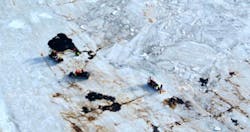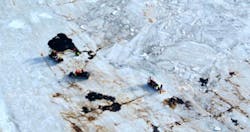Pipeline leaks Bakken oil into Yellowstone River
Ice on the Yellowstone River delayed cleanup efforts by response crews after a section of Bridger Pipeline LLC's Poplar Pipeline, which runs under the river, ruptured and spilled Bakken crude oil, said the US Environmental Protection Agency.
A 1-mile pipeline section crossing the river initially was buried 8 ft beneath the river. Bridger Pipeline notified authorities of a possible pipeline spill on Jan. 17. Response crews reported that much of the spilled oil 6 miles upstream from Glendive, Mont., was trapped under ice.
Crews tried to cut slots in the ice to recover the oil. In February, they reported the ice was too thin in some spots to get the necessary equipment on the river so that they could cut the ice and place plywood through the slots to trap the oil. Containment booms do not work well in ice, officials said.
Montana Gov. Steve Bullock (D) sent a Feb. 13 letter to US Sec. of Transportation Anthony Foxx asking him to send more pipeline inspectors to the state and schedule more inspections there.
"Oil spills in Montana's rivers are unacceptable and will not be tolerated," Bullock said. "As governor, I am working to ensure that those responsible for these spills are held accountable, the environment is cleaned up to our standards, and that we do everything we can to avoid another oil spill into Montana waters."
An estimated 12,000 bbl of oil leaked into the river, Bullock said. About 548 bbl was recovered but cold weather limited the ability of crews to recover additional oil, Bridger Pipeline spokesman Bill Salvin said. "We are staging resources so that when conditions are right, we can respond quickly," he told OGJ on Feb. 17.
Meanwhile, some Glendive, residents questioned whether the city water supply was contaminated, EPA said. Montana's Department of Environmental Quality notified municipal water utilities of the potential of crude oil passing by their water intakes and suggested water monitoring.
EPA said the Bridger Pipeline is 55 years old. Bridger Pipeline said the system was last inspected in 2012. A Yellowstone Pipeline Risk Assessment said bank erosion on the south side of the Bridger Pipeline crossing made the 12-in. line vulnerable to damage. The Yellowstone River Conservation District Council compiled the risk assessment in 2012.
On July 2, 2011, ExxonMobil Corp.'s Silvertip Pipeline ruptured near Laurel and spilled oil into the river. Cause of that rupture was high river flow, and the spill released an estimated 1,000 bbl of oil into the river.
Bridger Pipeline is part of the Poplar Pipeline system running from Canada to Baker. It carries crude oil from the Bakken formation. In Montana, the pipeline receives oil at the Poplar Station in Roosevelt County, Fisher and Richey Stations in Richland County, and at Glendive in Dawson County
During February, excavation crews dug up sections of Poplar Pipeline on both sides of the river. The federal Pipeline and Hazardous Safety Administration said response crews were trying to recover oil believed to be trapped in the broken pipeline.
Four pipelines run near the Yellowstone River in Dawson County with two running parallel to the river and two crossing under the river.
Bullock requests more inspections
Bullock asked Foxx to instruct the US Pipeline and Hazardous Materials Safety Administration to reevaluate its inspection schedule. Bullock suggested more frequent inspections and asked that deeper minimum cover depths be required for pipelines passing under rivers.
The governor also has asked Foxx to do the following:
- Direct PHMSA to base additional pipeline inspectors in Montana with a priority of inspecting the 3,800 miles of pipelines in the state for which the agency is responsible.
- Compile and report to Bullock's office a list of all oil pipelines PHMSA regulates in Montana, including data on pipeline ownership, age, depth of cover, whether the pipeline has been horizontally directionally drilled, latest PHMSA and company inspection reports, and future PHMSA and company inspection schedules for the next 2 years.
- Provide professional technical assistance to Montana so that as the state considers granting easements, it has the best science to impose protective conditions for pipeline river crossings.
- Direct PHMSA to take the necessary steps to improve timely and comprehensive sharing of information with the state, specifically Montana's Department of Environmental Quality along with Natural Resources and Conservation.
In a separate memo, Bullock instructed state agencies to review and determine the state's authority to place conditions on the siting of both existing and future easements for pipelines that cross navigable waters.
The state Fish, Wildlife, and Parks Department in February advised against eating fish caught downstream of the spill. Hydrocarbons were found in laboratory tests of fish samples from near Glendive.
Various types of fish were sent to laboratories in Montana and Wisconsin, which tested edible muscle tissue as well as internal organs for polycyclic aromatic hydrocarbons (PAHs). An FWP biologist said test results showed detectable PAHs levels in some samples.

